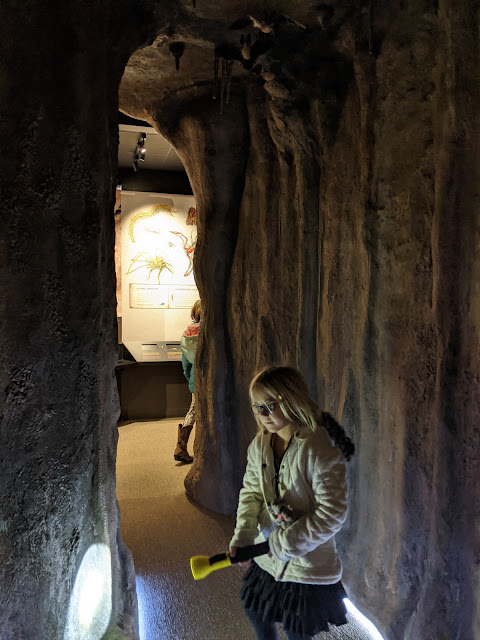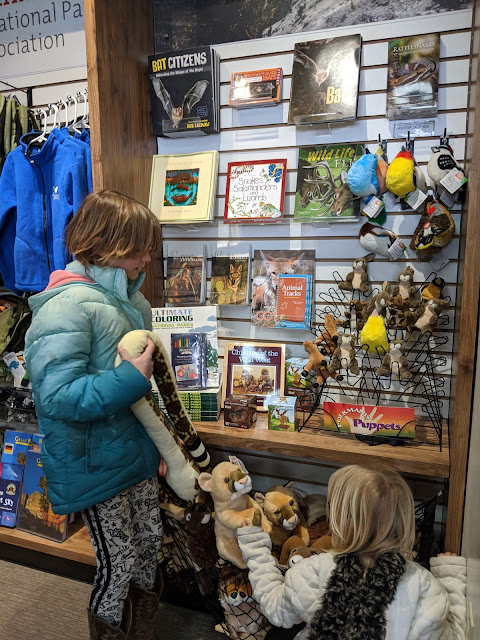Lehman Caves Visitor Center has some new exhibits! The theme is Discover the Dark, and part of it is about Lehman Caves and part is about the dark night skies. Park staff have been working with contractors for the past two years to make this exhibit come to fruition. Funding came from the Southern Nevada Public Lands Management Act (SNPLMA).
The exhibits opened February 15, 2020, and I took the family (and a friend) up the next day to see their reactions. The kids immediately stopped for a long time at the cave map, asking if they could touch the 3d model (yes!, but gently).
The girls then saw the flashlights and grabbed them. Then they got distracted by the microscope.
The reason for the flashlights is to Enter the Dark (Ingrese a la Oscuridad---all the signs are in English and Spanish).

On the other side of the curtains there is minimal lighting, and you can use the flashlights to find cave creatures.
If you listen carefully, you can hear bats squeaking. Take a look up to see some simulated ones!
The tunnel isn't long, but it's fun.
On the other is the mini-laboratory (with my friend Kristin's awesome art of cave critters). The exhibit isn't fully completed, so Desert Girl had fun looking at her fingers under the microscope.

I encouraged the kids to look at the giant cave creatures along another wall.

I don't think they read much, but they had fun touching! The cave creatures are nice and low for kids to be able to reach easily.
Another exhibit that invites touching is Protecting the Night Sky, which lets you flip a light switch to simulate how light pollution dims our view of the night skies.
And in Cave Conservation, you can touch half a stalagmite. It's already looking shiny after a few days of touching, compared to the protected part under the glass. Hopefully this will show folks how important it is not to touch in the cave! (p.s., That's a photo of some lint cleaning in the cave in the background!)
Over in the astronomy section is a giant planisphere to show you what's up in the sky on certain dates at certain times.
There's also a guessing game related to animals that are out at night. Mainly the kids just wanted to swirl the circles, though.
Desert Boy kept going back to the 3d model of the cave. He really liked that. (None of them read "How Did Lehman Caves Form?", which is in the background and really fascinating.)
I love that there's a big cave shield prominently displayed. Lehman Caves has so many cave shields! They are currently being counted. Most are attached to the wall or ceiling, but there are a notable number that rise from the floor.
The Western National Parks Association (WNPA) bookstore has also been redone and looks so good.
The visitor center isn't very big, but there's a lot of cool info there now about the cave and dark skies. Hopefully everyone can learn something new and get a taste of what the cave environment is like! Plus there's more to see that I didn't show (don't want to give it all away!).
The Lehman Caves Visitor Center is open every day, from 8 am to at least 4 pm. Check the
Great Basin National Park website for more details. Also, if you'd like to go on a cave tour, it's best to
book ahead, as the tours were sold out for President's Day weekend. If you come on weekdays during the winter, the tours are much smaller, and you get some specialized info. Have fun Discovering the Dark!






















































